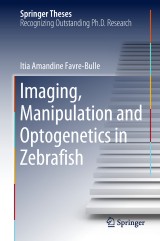Details

Imaging, Manipulation and Optogenetics in Zebrafish
Springer Theses
|
96,29 € |
|
| Verlag: | Springer |
| Format: | |
| Veröffentl.: | 12.08.2018 |
| ISBN/EAN: | 9783319962504 |
| Sprache: | englisch |
Dieses eBook enthält ein Wasserzeichen.
Beschreibungen
The work described here investigates the advantages and limitations of using laser light for the deep in-vivo illumination and micromanipulation of the neuronal system in zebrafish. To do so, it combines and develops novel optical methods such as optogenetics, light sheet microscopy and optical micromanipulation. It also demonstrates, for the first time, that directional and focused laser beams can successfully be used to target large objects at considerable depth in a living organism to exert purely optical force – in this case on otoliths (ear stones) – and create fictive vestibular stimuli in a stationary animal. The behavioural study and simultaneous imaging of the whole brain reveal the location of the brain cells specific to each ear stone. Elucidating these fundamental neural processes holds substantial value for basic neuroscience researchers, who still have only a vague grasp of how brain circuits mediate perception. As such, it represents highly innovative research that has already led to high-impact publications and is now being intensively pursued.<p></p>
Introduction.- Light Scattering in Brain Tissue Using Monte Carlo Method.- Scattering in Zebrafish Brain for Optogenetics.- Optical Systems to Decode Brain Activity.- Investigation of Optical Properties of Otoliths with Optical Trapping.- Optical Manipulation of Otoliths in-vivo.- Conclusion.<p></p>
The work described here investigates the advantages and limitations of using laser light for the deep in-vivo illumination and micromanipulation of the neuronal system in zebrafish. To do so, it combines and develops novel optical methods such as optogenetics, light sheet microscopy and optical micromanipulation. It also demonstrates, for the first time, that directional and focused laser beams can successfully be used to target large objects at considerable depth in a living organism to exert purely optical force – in this case on otoliths (ear stones) – and create fictive vestibular stimuli in a stationary animal. The behavioural study and simultaneous imaging of the whole brain reveal the location of the brain cells specific to each ear stone. Elucidating these fundamental neural processes holds substantial value for basic neuroscience researchers, who still have only a vague grasp of how brain circuits mediate perception. As such, it represents highly innovative research that has already led to high-impact publications and is now being intensively pursued.<p></p>
Nominated as an outstanding Ph.D thesis by the University of Queensland, Sydney, Australia Develops and combines novel optical methods for micromanipulation of neuronal system Describes an intensively pursued research area that promises important advances in basic neuroscience
Diese Produkte könnten Sie auch interessieren:

Femtosecond Optical Frequency Comb: Principle, Operation and Applications

von: Jun Ye, Steven T. Cundiff

149,79 €















